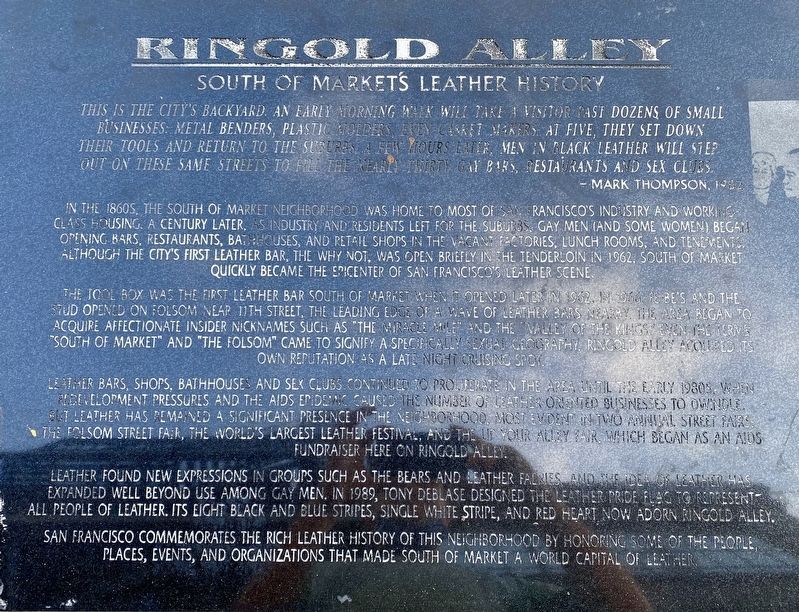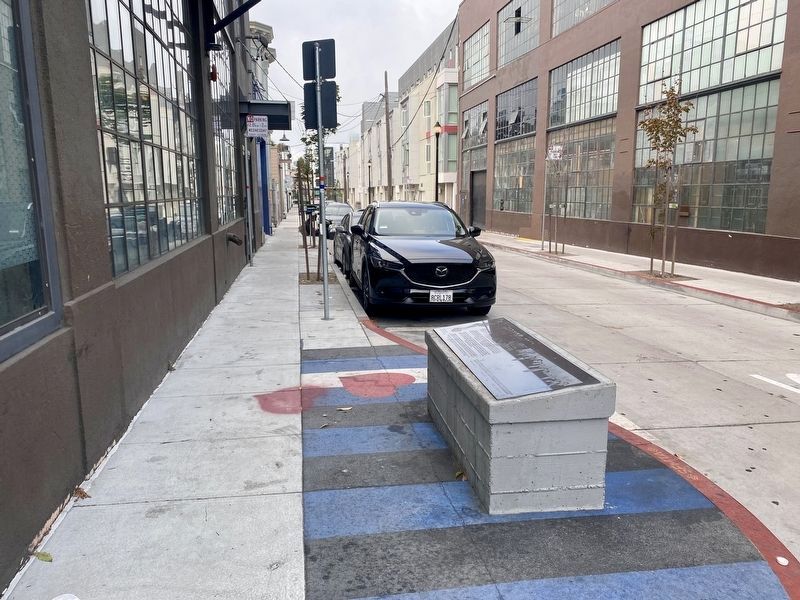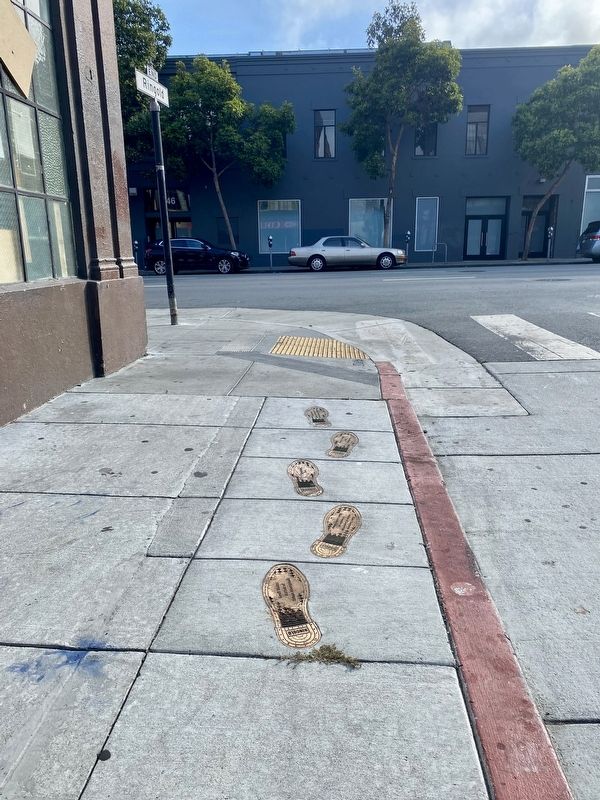SoMa in San Francisco City and County, California — The American West (Pacific Coastal)
Ringold Alley
South of Market's Leather History
This is the city's backyard. An early morning walk will take a visitor past dozens of small businesses: metal benders, plastic molders, even casket makers. At five, they set down their tools and return to the suburbs. A few hours later men in black leather will step out on these same streets to fill the nearly thirty gay bars, restaurants and sex clubs.
- Mark Thompson, 1982
In the 1860s, the South of Market neighborhood was home to most of San Francisco's industry and working class housing. A century later, as industry and residents left for the suburbs, gay men (and some women) began opening bars, restaurants, bathouses, and retail shops in the vacant factories, lunch rooms, and tenements. Although the city's first leather bar, The Why Not, was open briefly in the Tenderloin in 1962, South of Market quickly became the epicenter of San Francisco's leather scene.
The Tool Box was the first leather bar South of Market when it opened later in 1962. In 1966, Fe-Be's and the Stud opened on Folsom near 11th street, the leading edge of a wave of leather bars nearby. The area began to acquire affectionate insider nicknames such as "the Miracle Mile” and the "Valley of the Kings.” Even the terms "South of Market” and "The Folsom” came to signify a specifically sexual geography. Ringold Alley acquired its own reputation as a late night cruising spot.
Leather bars, shops, bathhouses and sex clubs continued to proliferate in the area until the early 1980s, when redevelopment pressures and the AIDS epidemic caused the number of leather oriented businesses to dwindle. But leather has remained a significant presence in the neighborhood, most evident in two annual street fairs, the Folsom Street fair, the world's largest leather festival, and the Up Your Alley fair, which began as an AIDS fundraiser here on Ringold Alley
Leather found new expressions in groups such as the bears and leather fairies and the idea of leather has expanded well beyond use among gay men. In 1989, Tony Deblase designed the Leather Pride flag to represent all people of leather. Its eight black and blue stripes, single white stripe, and red heart now adorn Ringold Alley.
San Francisco commemorates the rich leather history of this neighborhood by honoring some of the people, places, events, and organizations that made South of Market a world capital of leather.
Erected 2017.
Topics. This historical marker is listed in these topic lists: Entertainment • Industry & Commerce. A significant historical year for this entry is 1962.
Location. 37° 46.409′ N, 122° 24.659′ W. Marker is in
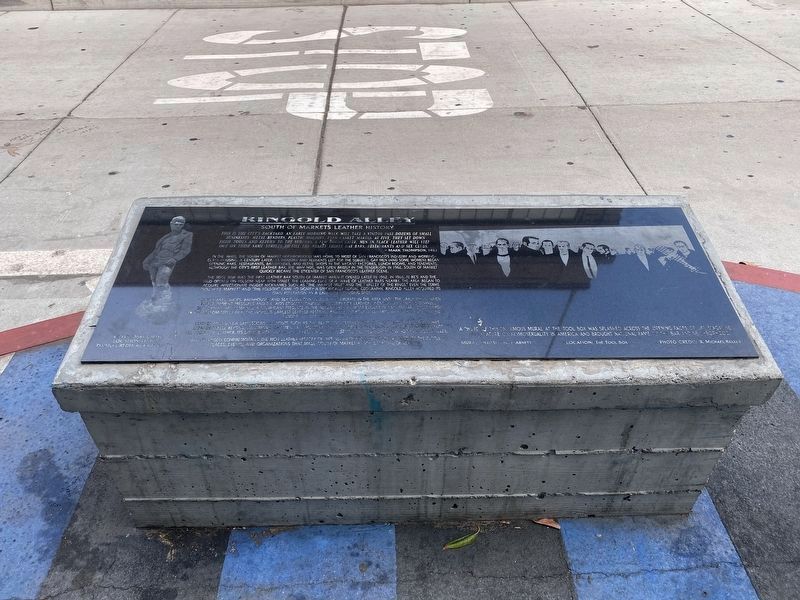
Photographed By Andrew Ruppenstein, July 30, 2021
2. Ringold Alley Marker (full marker)
The image on the left is of Mark Caffee's Leather David Statue, while the image to the right of the text is of a famous mural by Chuck Arnett (it was featured in Life Magazine in 1964 in an article on homosexuality in America).
Other nearby markers. At least 8 other markers are within walking distance of this marker. The Jackson Brewery (approx. 0.2 miles away); James Lick Baths / People's Laundry Bldg. (approx. ¼ mile away); Victoria Manalo Draves (approx. 0.4 miles away); Ashurbanipal Monument (approx. half a mile away); Pioneer Monument / California Native Americans (approx. half a mile away); Site of Woodward's Gardens (approx. 0.6 miles away); 220 Golden Gate Ave. (approx. 0.6 miles away); California Labor School (approx. 0.6 miles away). Touch for a list and map of all markers in San Francisco.
More about this marker. The marker is one of four components comprising Leather Memoir, a site-specific art installation stretching out along Ringold Alley (between 8th and 9th) that commemorates the history of leather culture in San Francisco. In addition to the marker, the other three components are pavers colored and arranged to form the Leather Pride flag, polished brass footprints inscribed with the names of persons who were important to leather culture, and recycled curbstones etched with the names of various businesses and locales that were important to leather
culture. The installation was designed by Miller Company, landscape architects.
Also see . . .
1. "Leather Memoir" at Ringold Alley (Miller Company). Miller Company, the landscape architecture firm that designed the art installation, provides a short history and context for Ringold Alley, along with artist mockups of the memorial and many photos of the design and construction. (Submitted on July 31, 2021.)
2. Folsom Street: The Miracle Mile (Found San Francisco). Two separate short historical essays on the development of the Folsom Street area with respect to gay/leather culture.
...Life magazine's June 26, 1964 feature, "Homosexuality in America," opened with a two-page spread of artist Chuck Arnett's mural towering over the men of San Francisco's Tool Box bar. This moody mural, occasionally enlivened by a smiling face, depicted imposing men in black, all variations on Marlon Brando and James Dean. No doubt many men found in this monument to homomasculinity a mirror against which to measure their own leather style. The Life article was the mass culture's first exposure to gay leather sexuality. Life also called San Francisco the "Gay Capital" of the United States, and the label has certainly stuck. In the 1991 anthology, Leatherfolk, Jack Fritscher described the article(Submitted on July 31, 2021.)as "an image-liberating historical issue that was read across the nation as an invitation to come to San Francisco and be a man's man."Photographed By Andrew Ruppenstein, July 30, 20214. Ringold Alley - set of inscribed metal footprintsThis is one of several sets of footprints found in Ringold Alley, with each footprint etched with the name of a person important to leather culture. For example, in this particular set are prints for Geoff Mains (author of Urban Aboriginals), Mark Thompson (author of Leatherfolk and a founder of Black Leather Wings), and Thom Gunn (poet).
3. San Francisco South of Market Leather History Alley (Wikipedia). Wikipedia's page for the Ringold Alley installation. (Submitted on July 31, 2021.)
4. Leather subculture (Wikipedia).
"The leather subculture denotes practices and styles of dress organized around sexual activities that involve leather garments, such as leather jackets, vests, boots, chaps, harnesses, or other items. Wearing leather garments is one way that participants in this culture self-consciously distinguish themselves from mainstream sexual cultures. Many participants associate leather culture with BDSM (Bondage/Discipline, Dominance/Submission, Sado/Masochism, also called "SM" or "S&M") practices and its many subcultures. For some, black leather clothing is an erotic fashion that expresses heightened masculinity or the appropriation of sexual power; love of motorcycles, motorcycle clubs and independence; and/or engagement in sexual kink or leather fetishism."(Submitted on July 31, 2021.)
Additional keywords. LGBT LGBTQ
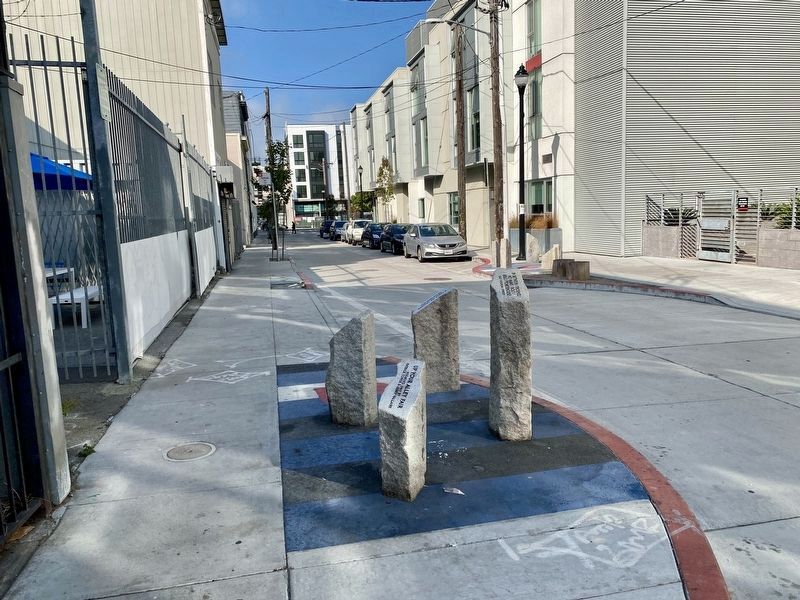
Photographed By Andrew Ruppenstein, July 30, 2021
5. Ringold Alley - set of inscribed curb stones
This is one of several sets of curbstones found in Ringold Alley, with each stone etched with the name of a business or entity that was important to leather culture. For example, in this particular set are stones for the Up Your Alley Fair (founded 1985 by Patrick Toner and Jerry Vallaire), A Taste of Leather (first leather shop in San Francisco), and the Folsom Street Fair (founded 1984 by Kathleen Connel and Michael Valerio).
Credits. This page was last revised on February 7, 2023. It was originally submitted on July 31, 2021, by Andrew Ruppenstein of Lamorinda, California. This page has been viewed 277 times since then and 24 times this year. Photos: 1, 2, 3, 4, 5. submitted on July 31, 2021, by Andrew Ruppenstein of Lamorinda, California.
